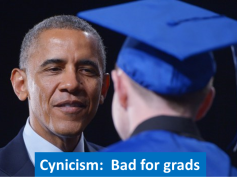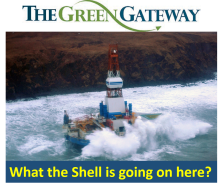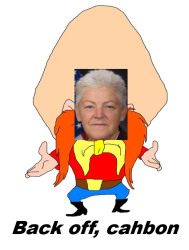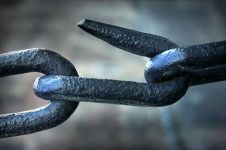President Obama is right: cynicism is toxic to climate solutions. But it can’t be cured just by naming it. He has to fight it.
The President continued where his Years of Living Dangerously interview left off last week, warding off cynicism in a commencement speech at UC Irvine focused mostly on climate:
We’ve got some big challenges. And if you’re fed a steady diet of cynicism that says nobody is trustworthy and nothing works, and there’s no way we can actually address these problems, then the temptation is too just go it alone, to look after yourself and not participate in the larger project of achieving our best vision of America.
Cynicism has never won a war, or cured a disease, or started a business, or fed a young mind, or sent men into space. Cynicism is a choice. Hope is a better choice.
I’m always in the market for hope, but it’s kind of a tough sell when the ice sheets are disintegrating and the President can’t stop talking about his all-of-the-above energy strategy, even in speeches about climate. It’s a tough sell when the science blares a 5-alarm global emergency, and the President steps on the message by announcing a $1 billion “resiliency” fund.
Look, I know the President can’t snap his fingers and turn it around. The nauseating truth is that the far end of what’s “politically possible” doesn’t even approach the near end of what’s urgently necessary. The President is clearly trying: fuel economy and power plant standards are meaningful steps forward against strong headwinds.
But it’s bittersweet to hear the President rallying the grads to solutions, when he still hasn’t done the most basic thing necessary to give them a fighting chance to succeed: stop making it worse.
The President articulated this simple idea in his climate address last June, when he said he would the approve Keystone XL tar sands pipeline only if it “does not significantly exacerbate the problem of carbon pollution.”
Bingo. At this stage of the game, how could we in good conscience do anything that “significantly exacerbates” the climate crisis?
Imagine how much more hopeful the graduates might be if the President clearly made that condition a firm and explicit Administration policy: the federal government will categorically stop doing things that significantly exacerbate the climate crisis — particularly things that facilitate new capital investments in long-lived fossil fuel infrastructure, “locking in” dangerous climate disruption. We’ve got so much work to do to make it better. So we’re done making it worse. Period.
You can’t tell the next generation to be engaged and optimistic one minute and slam the door in their face with new fossil fuel investments the next. As young American leaders including Oscar-winner Jared Leto told Secretary of State Kerry in their recent letter calling on the President to reject Keystone XL:
“The urgent climate imperative now – what our generation asks and expects of yours – is to give…solutions time to grow. We must not squander our precious time and capital now on making the problem intractably worse, especially when we are so bullish on the opportunities to make it better!”
We can’t put the fire out instantly, but we can stop spraying gas on it. That, so much more than the word “hope,” would feed hope.
The best hope food in the President’s commencement speech — the clearest nod to the real fight against the power of fossil fuels — was:
“You need to invest in what helps, and divest from what harms.”
Yes, you do.
—————————————————————————————————-
The whole speech:
THE WHITE HOUSE
Office of the Press Secretary
________________________________________________________________
For Immediate Release June 14, 2014
REMARKS BY THE PRESIDENT
AT UNIVERSITY OF CALIFORNIA-IRVINE COMMENCEMENT CEREMONY
Angel Stadium
Anaheim, California
12:10 P.M. PDT
THE PRESIDENT: Thank you. (Applause.) Hello, Anteaters! (Applause.) That is something I never thought I’d say. (Laughter.) Please, please take a seat.
To President Napolitano — which is a nice step up from Secretary; to Fred Ruiz, Vice Chair of the University of California Regents; Chancellor Drake; Representatives Loretta Sanchez and Alan Lowenthal; to the trustees and faculty — thank you for this honor. And congratulations to the Class of 2014! (Applause.)
Now, let me begin my saying all of you had the inside track in getting me here — because my personal assistant, Ferial, is a proud Anteater. (Applause.) Until today, I did not understand why she greets me every morning by shouting “Zot, Zot, Zot!” (Laughter.) It’s been a little weird. But she explained it to me on the way here this morning, because she’s very proud to see her brother, Sina, graduate today as well. (Applause.) So, graduates, obviously we’re proud of you, but let’s give it up for your proud family and friends and professors, because this is their day, too. (Applause.)
And even though he’s on the road this weekend, I also want to thank Angels centerfielder Mike Trout for letting me cover his turf for a while. (Applause.) He actually signed a bat for me, which is part of my retirement plan. (Laughter.) I will be keeping that. And this is a very cool place to hold a commencement. I know that UC Irvine’s baseball team opens College World Series play in Omaha right about now — (applause) — so let’s get this speech underway. If the hot dog guy comes by, get me one. (Laughter.)
Now, in additional to Ferial, graduates, I’m here for a simple reason: You asked. For those who don’t know, the UC Irvine community sent 10,000 postcards to the White House asking me to come speak today. (Applause.) Some tried to guilt me into coming. I got one that said, “I went to your first inauguration, can you please come to my graduation?” (Applause.) Some tried bribery: “I’ll support the Chicago Bulls.” Another said today would be your birthday — so happy birthday, whoever you are.
My personal favorite — somebody wrote and said, “We are super underrated!” (Laughter.) I’m sure she was talking about this school. But keep in mind, you’re not only the number-one university in America younger than 50 years old, you also hold the Guinness World Record for biggest water pistol fight. (Applause.) You’re pretty excited about that. (Laughter.)
“We are super underrated.” This young lady could have just as well been talking, though, about this generation. I think this generation of young people is super underrated.
In your young lives, you’ve seen dizzying change, from terror attacks to economic turmoil; from Twitter to Tumblr. Some of your families have known tough times during the course of the worst economic crisis since the Great Depression. You’re graduating into a still-healing job market, and some of you are carrying student loan debt that you’re concerned about. And yet, your generation — the most educated, the most diverse, the most tolerant, the most politically independent and the most digitally fluent in our history — is also on record as being the most optimistic about our future.
And I’m here to tell you that you are right to be optimistic. (Applause.) You are right to be optimistic. Consider this: Since the time most of you graduated from high school, fewer Americans are at war. More have health insurance. More are graduating from college. Our businesses have added more than 9 million new jobs. The number of states where you’re free to marry who you love has more than doubled. (Applause.) And that’s just some of the progress that you’ve seen while you’ve been studying here at UC Irvine.
But we do face real challenges: Rebuilding the middle class and reversing inequality’s rise. Reining in college costs. Protecting voting rights. Welcoming the immigrants and young dreamers who keep this country vibrant. Stemming the tide of violence that guns inflict on our schools. We’ve got some big challenges. And if you’re fed a steady diet of cynicism that says nobody is trustworthy and nothing works, and there’s no way we can actually address these problems, then the temptation is too just go it alone, to look after yourself and not participate in the larger project of achieving our best vision of America.
And I’m here to tell you, don’t believe the cynicism. Guard against it. Don’t buy into it. Today, I want to use one case study to show you that progress is possible and perseverance is critical. I want to show you how badly we need you — both your individual voices and your collective efforts — to give you the chance you seek to change the world, and maybe even save it.
I’m going to talk about one of the most significant long-term challenges that our country and our planet faces: the growing threat of a rapidly changing climate.
Now, this isn’t a policy speech. I understand it’s a commencement, and I already delivered a long climate address last summer. I remember because it was 95 degrees and my staff had me do it outside, and I was pouring with sweat — as a visual aid. (Laughter.) And since this is a very educated group, you already know the science. Burning fossil fuels release carbon dioxide. Carbon dioxide traps heat. Levels of carbon dioxide in our atmosphere are higher than they’ve been in 800,000 years.
We know the trends. The 18 warmest years on record have all happened since you graduates were born. We know what we see with our own eyes. Out West, firefighters brave longer, harsher wildfire seasons; states have to budget for that. Mountain towns worry about what smaller snowpacks mean for tourism. Farmers and families at the bottom worry about what it will mean for their water. In cities like Norfolk and Miami, streets now flood frequently at high tide. Shrinking icecaps have National Geographic making the biggest change in its atlas since the Soviet Union broke apart.
So the question is not whether we need to act. The overwhelming judgment of science, accumulated and measured and reviewed over decades, has put that question to rest. The question is whether we have the will to act before it’s too late. For if we fail to protect the world we leave not just to my children, but to your children and your children’s children, we will fail one of our primary reasons for being on this world in the first place. And that is to leave the world a little bit better for the next generation.
Now, the good is you already know all this. UC Irvine set up the first Earth System Science Department in America. (Applause.) A UC Irvine professor-student team won the Nobel Prize for discovering that CFCs destroy the ozone layer. (Applause.) A UC Irvine glaciologist’s work led to one of last month’s report showing one of the world’s major ice sheets in irreversible retreat. Students and professors are in the field working to predict changing weather patterns, fire seasons, and water tables — working to understand how shifting seasons affect global ecosystems; to get zero-emission vehicles on the road faster; to help coastal communities adapt to rising seas. And when I challenge colleges to reduce their energy use to 20 percent by 2020, UC Irvine went ahead and did it last year. Done. (Applause.) So UC Irvine is ahead of the curve. All of you are ahead of the curve.
Your generation reminds me of something President Wilson once said. He said, “Sometimes people call me an idealist. Well, that is the way I know I am an American.” That’s who we are.
And if you need a reason to be optimistic about our future, then look around this stadium. Because today, in America, the largest single age group is 22 years ago. And you are going to do great things. And I want you to know that I’ve got your back — because one of the reasons I ran for this office was because I believed our dangerous addiction to foreign oil left our economy at risk and our planet in peril. So when I took office, we set out to use more clean energy and less dirty energy, and waste less energy overall.
And since then, we’ve doubled the distance our cars will go on a gallon of gas by the middle of the next decade. We’ve tripled the electricity we harness from the wind, generating enough last year to power every home in California. We’ve multiplied the electricity we generate from the sun 10 times over. And this state, California, is so far ahead of the rest of the country in solar, that earlier this year solar power met 18 percent of your total power demand one day. (Applause.)
The bottom line is, America produces more renewable energy than ever, more natural gas than anyone. And for the first time in nearly two decades, we produce more oil here at home than we buy from other countries. And these advances have created jobs and grown our economy, and helped cut our carbon pollution to levels not seen in about 20 years. Since 2006, no country on Earth has reduced its total carbon pollution by as much as the United States of America. (Applause.)
So that’s all reason for optimism. Here’s the challenge: We’ve got to do more. What we’re doing is not enough. And that’s why, a couple weeks ago, America proposed new standards to limit the amount of harmful carbon pollution that power plants can dump into the air. And we also have to realize, as hundreds of scientists declared last month, that climate change is no longer a distant threat, but “has moved firmly into the present.” That’s a quote. In some parts of the country, weather-related disasters like droughts, and fires, and storms, and floods are going to get harsher and they’re going to get costlier. And that’s why, today, I’m announcing a new $1 billion competitive fund to help communities prepare for the impacts of climate change and build more resilient infrastructure across the country. (Applause.)
So it’s a big problem. But progress, no matter how big the problem, is possible. That’s important to remember. Because no matter what you do in life, you’re going to run up against big problems — in your own personal life and in your communities and in your country. There’s going to be a stubborn status quo, and there are going to be people determined to stymie your efforts to bring about change. There are going to be people who say you can’t do something. There are going to be people who say you shouldn’t bother. I’ve got some experience in this myself. (Laughter.)
Now, part of what’s unique about climate change, though, is the nature of some of the opposition to action. It’s pretty rare that you’ll encounter somebody who says the problem you’re trying to solve simply doesn’t exist. When President Kennedy set us on a course for the moon, there were a number of people who made a serious case that it wouldn’t be worth it; it was going to be too expensive, it was going to be too hard, it would take too long. But nobody ignored the science. I don’t remember anybody saying that the moon wasn’t there or that it was made of cheese. (Laughter.)
And today’s Congress, though, is full of folks who stubbornly and automatically reject the scientific evidence about climate change. They will tell you it is a hoax, or a fad. One member of Congress actually says the world is cooling. There was one member of Congress who mentioned a theory involving “dinosaur flatulence” — which I won’t get into. (Laughter.)
Now, their view may be wrong — and a fairly serious threat to everybody’s future — but at least they have the brass to say what they actually think. There are some who also duck the question. They say — when they’re asked about climate change, they say, “Hey, look, I’m not a scientist.” And I’ll translate that for you. What that really means is, “I know that manmade climate change really is happening, but if I admit it, I’ll be run out of town by a radical fringe that thinks climate science is a liberal plot, so I’m not going to admit it.” (Applause.)
Now, I’m not a scientist either, but we’ve got some really good ones at NASA. I do know that the overwhelming majority of scientists who work on climate change, including some who once disputed the data, have put that debate to rest. The writer, Thomas Friedman, recently put it to me this way. He were talking, and he says, “Your kid is sick, you consult 100 doctors; 97 of them tell you to do this, three tell [you] to do that, and you want to go with the three?”
The fact is, this should not be a partisan issue. After all, it was Republicans who used to lead the way on new ideas to protect our environment. It was Teddy Roosevelt who first pushed for our magnificent national parks. It was Richard Nixon who signed the Clean Air Act and opened the EPA. George H.W. Bush — a wonderful man who at 90 just jumped out of a plane in a parachute — (laughter) — said that “human activities are changing the atmosphere in unexpected and unprecedented ways.” John McCain and other Republicans publicly supported free market-based cap-and-trade bills to slow carbon pollution just a few years ago — before the Tea Party decided it was a massive threat to freedom and liberty.
These days, unfortunately, nothing is happening. Even minor energy efficiency bills are killed on the Senate floor. And the reason is because people are thinking about politics instead of thinking about what’s good for the next generation. What’s the point of public office if you’re not going to use your power to help solve problems? (Applause.)
And part of the challenge is that the media doesn’t spend a lot of time covering climate change and letting average Americans know how it could impact our future. Now, the broadcast networks’ nightly newscasts spend just a few minutes a month covering climate issues. On cable, the debate is usually between political pundits, not scientists. When we introduced those new anti-pollution standards a couple weeks ago, the instant reaction from the Washington’s political press wasn’t about what it would mean for our planet; it was what would it mean for an election six months from now. And that kind of misses the point. Of course, they’re not scientists, either.
And I want to tell you all this not to discourage you. I’m telling you all this because I want to light a fire under you. As the generation getting shortchanged by inaction on this issue, I want all of you to understand you cannot accept that this is the way it has to be.
The climate change deniers suggest there’s still a debate over the science. There is not. The talking heads on cable news suggest public opinion is hopelessly deadlocked. It is not. Seven in ten Americans say global warming is a serious problem. Seven in ten say the federal government should limit pollution from our power plants. And of all the issues in a recent poll asking Americans where we think we can make a difference, protecting the environment came out on top. (Applause.)
So we’ve got public opinion potentially on our side. We can do this. We can make a difference. You can make a difference. And the sooner you do, the better — not just for our climate, but for our economy. There’s a reason that more than 700 businesses like Apple and Microsoft, and GM and Nike, Intel, Starbucks have declared that “tackling climate change is one of America’s greatest economic opportunities in the 21st century.” The country that seizes this opportunity first will lead the way. A low-carbon, clean energy economy can be an engine for growth and jobs for decades to come, and I want America to build that engine. Because if we do, others will follow. I want those jobs; I want those opportunities; I want those businesses right here in the United States of America. (Applause.)
Developing countries are using more and more energy, and tens of millions of people are entering the global middle class, and they want to buy cars and refrigerators. So if we don’t deal with this problem soon, we’re going to be overwhelmed. These nations have some of the fastest-rising levels of carbon pollution. They’re going to have to take action to meet this challenge. They’re more vulnerable to the effects of climate change than we are. They’ve got even more to lose. But they’re waiting to see what does America do. That’s what the world does. It waits to watch us act. And when we do, they move. And I’m convinced that on this issue, when America proves what’s possible, then they’re going to join us.
And America cannot meet this threat alone. Of course, the world cannot meet it without America. This is a fight that America must lead. So I’m going to keep doing my part for as long as I hold this office and as long as I’m a citizen once out of office. But we’re going to need you, the next generation, to finish the job.
We need scientists to design new fuels. We need farmers to help grow them. We need engineers to invent new technologies. We need entrepreneurs to sell those technologies. (Applause.) We need workers to operate assembly lines that hum with high-tech, zero-carbon components. We need builders to hammer into place the foundations for a clean energy age. We need diplomats and businessmen and women, and Peace Corps volunteers to help developing nations skip past the dirty phase of development and transition to sustainable sources of energy.
In other words, we need you. (Applause.) We need you. And if you believe, like I do, that something has to be done on this, then you’re going to have to speak out. You’re going to have to learn more about these issues. Even if you’re not like Jessica and an expert, you’re going to have to work on this. You’re going to have to push those of us in power to do what this American moment demands. You’ve got to educate your classmates, and colleagues, and family members and fellow citizens, and tell them what’s at stake. You’ve got to push back against the misinformation, and speak out for facts, and organize others around your vision for the future.
You need to invest in what helps, and divest from what harms. And you’ve got to remind everyone who represents you, at every level of government, that doing something about climate change is a prerequisite for your vote.
It’s no accident that when President Kennedy needed to convince the nation that sending Americans into space was a worthy goal, he went to a university. That’s where he started. Because a challenge as big as that, as costly as that, as difficult as that, requires a spirit of youth. It requires a spirit of adventure; a willingness to take risks. It requires optimism. It requires hope. That day, a man told us we’d go to the moon within a decade. And despite all the naysayers, somehow we knew as a nation that we’d build a spaceship and we’d meet that goal.
That’s because we’re Americans — and that’s what we do. Even when our political system is consumed by small things, we are a people called to do big things. And progress on climate change is a big thing. Progress won’t always be flashy; it will be measured in disasters averted, and lives saved, and a planet preserved — and days just like this one, 20 years from now, and 50 years from now, and 100 years from now. But can you imagine a more worthy goal — a more worthy legacy — than protecting the world we leave to our children?
So I ask your generation to help leave us that legacy. I ask you to believe in yourselves and in one another, and above all, when life gets you down or somebody tells you you can’t do something, to believe in something better.
There are people here who know what it means to dream. When Mohamad Abedi was a boy, the suffering he saw in refugee camps in Lebanon didn’t drive him into despair — it inspired him to become a doctor. And when he came to America, he discovered a passion for engineering. So here, at UC Irvine, he became a biomedical engineer to study the human brain. (Applause.) And Mohamad said, “Had I never come to the United States, I would have never had the ability to do the work that I’m doing.” He’s now going to CalTech to keep doing that work.
Cinthia Flores is the daughter of a single mom who worked as a seamstress and a housekeeper. (Applause.) The first in her family to graduate from high school. The first in her family to graduate from college. And in college, she says, “I learned about myself that I was good at advocating for others, and that I was argumentative — so maybe I should go to law school.” And, today, Cinthia is now the first in her family to graduate from law school. And she plans to advocate for the rights of workers like her mom. (Applause.) She says, “I have the great privilege and opportunity to answer the call of my community.” “The bottom line,” she says, “is being of service.”
On 9/11, Aaron Anderson was a sophomore in college. Several months later, he was in training for Army Special Forces. He fought in Afghanistan, and on February 28th, 2006, he was nearly killed by an IED. He endured dozens of surgeries to save his legs, months of recovery at Walter Reed. When he couldn’t physically return to active duty, he devoted his time to his brothers in arms, starting two businesses with fellow veterans, and a foundation to help fellow wounded Green Beret soldiers. And then he went back to school. And last December, he graduated summa cum laude from UC Irvine. And Aaron is here today, along with four soon-to-be commissioned ROTC cadets, and 65 other graduating veterans. And I would ask them to stand and be recognized for their service. (Applause.)
The point is, you know how to dream. And you know how to work for your dreams. And, yes, sometimes you may be “super underrated.” But usually it’s the underrated, the underdogs, the dreamers, the idealists, the fighters, the argumentative — those are the folks who do the biggest things.
And this generation — this 9/11 generation of soldiers; this new generation of scientists and advocates and entrepreneurs and altruists — you’re the antidote to cynicism. It doesn’t mean you’re not going to get down sometimes. You will. You’ll know disillusionment. You’ll experience doubt. People will disappoint you by their actions. But that can’t discourage you.
Cynicism has never won a war, or cured a disease, or started a business, or fed a young mind, or sent men into space. Cynicism is a choice. Hope is a better choice. (Applause.)
Hope is what gave young soldiers the courage to storm a beach and liberate people they never met.
Hope is what gave young students the strength to sit in and stand up and march for women’s rights, and civil rights, and voting rights, and gay rights, and immigration rights.
Hope is the belief, against all evidence to the contrary, that there are better days ahead, and that together we can build up a middle class, and reshape our immigration system, and shield our children from gun violence, and shelter future generations from the ravages of climate change.
Hope is the fact that, today, the single largest age group in America is 22 years old who are all just itching to reshape this country and reshape the world. And I cannot wait to see what you do tomorrow.
Congratulations. (Applause.) Thank you, Class of 2014. God bless you. God bless the United States of America. (Applause.)

 This is precisely Big Oil’s game. No one would consciously choose the dystopian future we’ll get if we burn all the oil, melt all the ice, and then drill for more where the ice used to be. So their only hope of keeping their grip on our economy is to convince us that we have no choice. And for now, the Port Commissioners seem to have accepted that verdict. Never mind that in the world where we burn Arctic oil, the Port – and coastal cities everywhere – sink under rising, acidified oceans.
This is precisely Big Oil’s game. No one would consciously choose the dystopian future we’ll get if we burn all the oil, melt all the ice, and then drill for more where the ice used to be. So their only hope of keeping their grip on our economy is to convince us that we have no choice. And for now, the Port Commissioners seem to have accepted that verdict. Never mind that in the world where we burn Arctic oil, the Port – and coastal cities everywhere – sink under rising, acidified oceans.


 Posted by kcgolden
Posted by kcgolden 







